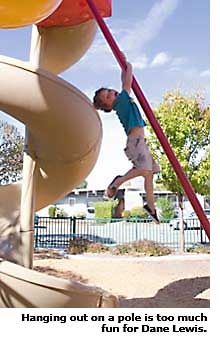Work in Progress: 19th Avenue - San Mateo - Page 2
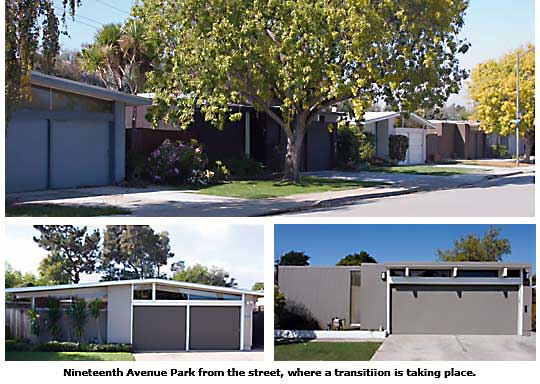
"Are those Eichlers?!" Viv Hwang exclaimed when she spotted the Nineteenth Avenue Park while house hunting with her husband Jeff Paladini. Hwang and Paladini, Eichler enthusiasts for years, were excited by their find—and by finding out that the homes in Nineteenth Avenue Park were selling for about $300,000 less than homes in the Highlands.
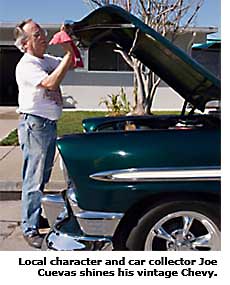
"We made an offer on a teardown in the Highlands that would have cost more than this house," Paladini says of the home they bought in 2002.
A stroll through Nineteenth Avenue Park reveals a compact neighborhood, roughly rectangular but with gently curving streets, that is protected from through traffic and hidden from the outside world because there are only two streets that lead in and out (although six of the Eichlers face, not into the neighborhood, but out, along one of the boundary streets).
Lots are among the smallest in any Eichler subdivision outside of San Francisco, roughly 5,000 to 5,500 square feet (except for some cul-de-sac and corner lots, some of which approach 10,000 square feet).
Because the neighborhood is set off from its neighbors—and despite the buzz of traffic from 101 and 92 and of airplane traffic to nearby SFO—residents praise Nineteenth Avenue Park's quiet. The lack of overhead utility lines adds to the neighborhood's charm. The relative lack of street trees detracts. Original cherry trees planted along several streets died long ago.
There are essentially three original house plans, three-bedroom and four-bedroom layouts, many with an 'all-purpose room' used either for dining or, more commonly, for the TV. Some homes are flat-roofed with a taller section over the main living areas. Others are low gabled. Corner houses have shed roofs over one section, flat roofs over another.
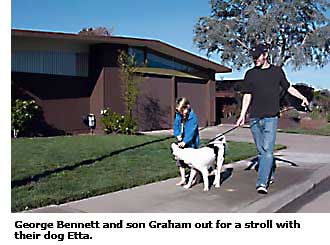
These houses were designed before the Eichler atrium was introduced, but all have terraces opening off living areas and bedrooms.
The neighborhood only has one house that gained a second story, and three or four that were either remodeled or rebuilt to no longer resemble Eichlers. Most of the homes retain their historic looks—though Colonial shutters and antique-style carriage lamps are common, and projecting bay windows and vinyl siding appear here and there.
A very persuasive garage door salesman appears to have passed through the neighborhood some time ago, as a surprising number of original sliding-garage doors have been replaced with automated ones that sport panels or sunbursts.
Although a couple of years ago one house was converted into what newcomer Ivan Ma called "an Eichler plus a pueblo-style melded together," no one in Nineteenth Avenue Park seems anxious to impose design controls. Neighbors who appreciate the Eichler aesthetic sometimes proselytize to those who do not.
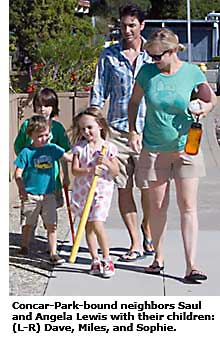
Perhaps 15 percent of the homes are rentals, which account for most of the poorly tended lawns, neighbors say. Ten or more houses serve as board-and-care homes for disabled or elderly people, and at least one houses drug rehab clients.
On the whole, neighbors say, the board-and-care homes are good neighbors, and several have been meticulously restored. But some neighbors, including Paladini, worry that if many more open, Nineteenth Avenue Park could become more of a business district and less a neighborhood of families.
Besides the homes themselves and the convenient location, there is much to love about Nineteenth Avenue Park, residents say. The schools have long been superb. A Trader Joe's grocery is five minutes away. "There's definitely no crime," Koehn says.
And people in the neighborhood have always gotten involved with the wider community. Before buying in the neighborhood, Ken White, who knows everyone in the county through his job as president of the Peninsula Humane Society, asked folks in the know about Nineteenth Avenue Park.
"We were told it is a very engaged neighborhood," he says. "It's always had a neighborhood voice. It was a neighborhood that looks out for its own interests."
Cheryl Hylton, a former teacher and fundraiser for nonprofit organizations, has emerged as the leading neighborhood activist over the past decade. The challenges she has faced arise because one of the neighborhood's greatest pluses—its central location—has also turned out to be one of its greatest minuses.
